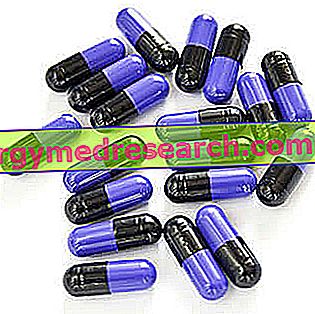
Scientific name
Atropa belladonna L.Family
SolanaceaeOrigin
Belladonna grows spontaneously in Europe, northern Africa, middle and western Asia, and in mountain forests.
Used Parts
The dried greenish leaves of the plant are used.
Chemical constituents
- Tropane alkaloids used as such in therapy: scopolamine, hyoscyamine and atropine.
Belladonna in Herbalist: Property of Belladonna
As regards the properties of the belladonna, a distinction must be made based on the type of alkaloid that is used and, above all, given that the plant is very toxic, medical prescription is essential (accidental ingestion of the berries can cause death) .
Biological activity
As mentioned, belladonna is a very toxic plant and, for this reason, no traditional extractive form should be used, except as a medicinal product, in the form of a standardized extract.
However, the belladonna plays a role of some importance in the medical field. In fact, from this plant active ingredients (tropane alkaloids) are extracted which are part of the composition of real drugs used in the treatment of different types of disorders.
The tropane alkaloids contained in the belladonna, in fact, exert an antimuscarinic type action (or anticholinergic if you prefer) and - depending on the organ or tissue on which they act - cause different effects.
Atropine is available in pharmaceutical injectable preparations with indications for the treatment of sinus bradycardia (especially if complicated by hypotension) and for pre-anesthetic medication to decrease salivation and excessive respiratory tract secretions.
In fact, atropine - thanks to its anticholinergic activity - is able to reduce the release of acetylcholine at the level of the atrial sinus node, thus inducing an increase in heart rate; moreover, it has a bronchodilating action and a reduction in tracheobronchial secretion.
Atropine is also included in the composition of eye drops that are used in eye exams, because - thanks to the blockage it exerts on muscarinic receptors present at the ocular level - it is able to induce mydriasis and to block the ciliary muscle thus preventing focusing. (cycloplegic action).
Scopolamine (or l-ioscina, or joscina), on the other hand, can be found in medicinal products for injectable use or in the form of transdermal patches for the treatment of nausea and vomiting. Furthermore, it is the active ingredient of several drugs used against spasms of the gastrointestinal tract and genitourinary tract (Erion®, Addofix®, Buscopan®, Antispasmin colica® Buscopan compositum®), thanks to the relaxation action on the smooth muscles of these apparatuses exercised, precisely, by blocking muscarinic receptors.
However, for more detailed information on the mechanisms of action of tropane alkaloids, we recommend reading the article dedicated "Antimuscarinic drugs - atropine and scopolamine".
Belladonna in folk medicine and homeopathy
In folk medicine, belladonna leaves are used in poultices to be applied directly on the affected area in the case of neurovegetative disorders, hyperkinesia, hyperhidrosis and bronchial asthma. Furthermore, belladonna is also used in folk medicine for the treatment of gastrointestinal pain, muscle pain and bronchitis.
Belladonna is also widely used in homeopathic medicine, where it can be found in the form of granules, tablets, drops and suppositories. In this context, the plant is used to treat a wide variety of disorders, such as fever, inflammation and acute airway infections, headaches, acute meningitis, convulsions, spasms, allergic conjunctivitis, sties, dry eyes, photophobia, inflammation of the skin, acne, erythema, inflammation of the gastrointestinal tract and urogenital and joint inflammation.
The dose of homeopathic remedy to be taken can vary from one individual to another, also depending on the type of disorder to be treated and the type of homeopathic preparation and dilution that is intended to be used.
Side effects
In the event of ingestion of high quantities of belladonna or its preparations, atropine poisoning may occur which is manifested by serious symptoms, such as: tachycardia, dry mouth, mydriasis, restlessness, hallucinations, delusions, respiratory depression, coma, collapse and, in the most serious cases, death can also occur.
The lethal dose depends on the content of atropine.
Due to the toxicity of the plant, therefore, its use is not strongly recommended in traditional preparations, but only in the form of medicinal specialties and only under the doctor's prescription.
Contraindications
Caution in use in case of bradycardia, bronchial asthma and glaucoma.
Belladonna - Warnings
The intake of the plant as a phytotherapic is not recommended, except in the forms provided for by the Pharmacopoeia and the medical-pharmaceutical handbook, under strict medical supervision.
Pharmacological Interactions
As far as belladonna is concerned, there are numerous drug interactions that can be encountered. Summing or antagonism effects may occur with:
- antidepressants;
- antiparkinsonian drugs;
- glaucoma;
- antiarrhythmic;
- antispasmodics;
- anticholinergics;
- antihistamines;
- neuroleptics.



